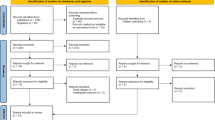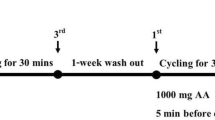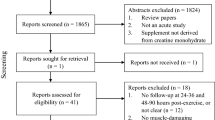Abstract
Background
Vitamin C (ascorbic acid) seems to attenuate the overproduction of reactive species during and after exercises. Yet, no meta-analysis has summarized the magnitude of this effect. The objective of this study was to systematically review the effects of vitamin C supplementation on oxidative stress, inflammatory markers, damage, soreness, and the musculoskeletal functionality after a single bout of exercise.
Methods
Major electronic databases were searched, from inception to September 2019, for placebo-controlled randomized clinical trials (RCTs) that evaluated the effects of vitamin C supplementation on oxidative stress parameters, inflammation markers, muscle damage, muscle soreness, and muscle functionality after a single bout of exercise in healthy volunteers. Random-effects modelling was used to compare mean changes from pre- to postexercise in participants that were supplemented with vitamin C versus placebo. Data were reported as standard mean difference (SMD) and 95% confidence interval (CI).
Results
A total of 18 RCTs, accounting for 313 participants (62% males, median age = 24 years) were included. Vitamin C supplementation reduced lipid peroxidation immediately (SMD = − 0.488; 95% CI = − 0.888 to − 0.088), 1 h (SMD = − 0.521; 95% CI = − 0.911 to − 0.131) and between 1 and 2 h (SMD = − 0.449; 95% CI = − 0.772 to − 0.126) following exercise. Exercise induced interleukin-6 (IL-6) response was attenuated 2 h (SMD = − 0.764; 95% CI = − 1.279 to − 0.248) and between 1 and 2 h (SMD = − 0.447; 95% CI = − 0.828 to − 0.065) after exercise. No effects of vitamin C supplementation were found on creatine kinase (CK), C-reactive protein (CRP), cortisol levels, muscle soreness, and muscle strength.
Conclusion
Vitamin C supplementation attenuates the oxidative stress (lipid peroxidation) and inflammatory response (IL-6) to a single bout of exercise.
Registration
PROSPERO (CRD42018094222).


Similar content being viewed by others
References
Egan B, Zierath JR (2013) Exercise metabolism and the molecular regulation of skeletal muscle adaptation. Cell Metab 17:162–184. https://doi.org/10.1016/j.cmet.2012.12.012
Heinonen I, Kalliokoski KK, Hannukainen JC et al (2014) Organ-specific physiological responses to acute physical exercise and long-term training in humans. Physiology 29:421–436. https://doi.org/10.1152/physiol.00067.2013
Schuch FB, Vancampfort D, Firth J et al (2018) Physical activity and incident depression: a meta-analysis of prospective cohort studies. Am J Psychiatry 175:631–648. https://doi.org/10.1176/appi.ajp.2018.17111194
Schuch FB, Stubbs B, Meyer J et al (2019) Physical activity protects from incident anxiety: a meta-analysis of prospective cohort studies. Depress Anxiety. https://doi.org/10.1002/da.22915
Pedersen BK, Saltin B (2015) Exercise as medicine—evidence for prescribing exercise as therapy in 26 different chronic diseases. Scand J Med Sci Sports 25:1–72. https://doi.org/10.1111/sms.12581
Garber CE, Blissmer B, Deschenes MR et al (2011) American College of Sports Medicine. Quantity and quality of exercise for developing and maintaining neuromotor fitness in apparently healthy adults: guidance for prescribing exercise. Med Sci Sport Exerc 43:1334–1359. https://doi.org/10.1249/MSS.0b013e318213fefb
Powers SK, Nelson WB, Hudson MB (2011) Exercise-induced oxidative stress in humans: cause and consequences. Free Radic Biol Med 51:942–950. https://doi.org/10.1016/j.freeradbiomed.2010.12.009
Teixeira ADO, da Silva Paulitsch F, Umpierre MDM et al (2014) Inflammatory response after session of resistance exercises in untrained volunteers. Acta Sci 37:31–39. https://doi.org/10.4025/actascihealthsci.v37i1.24149
Smith LL (2000) Cytokine hypothesis of overtraining: a physiological adaptation to excessive stress? Med Sci Sports Exerc 32:317–331. https://doi.org/10.1097/00005768-200002000-00011
Powers SK, Jackson MJ (2008) Exercise-induced oxidative stress: cellular mechanisms and impact on muscle force production. Physiol Rev 88:1243–1276. https://doi.org/10.1152/physrev.00031.2007.Exercise-Induced
Magal M, Dumke CL, Urbiztondo ZG et al (2010) Relationship between serum creatine kinase activity following exercise-induced muscle damage and muscle fibre composition. J Sports Sci 28:257–266. https://doi.org/10.1080/02640410903440892
Cheung K, Hume PA, Maxwell L (2003) Delayed onset muscle soreness treatment strategies and performance factors karoline. Sport Med 33:145–164
Peternelj T-T, Coombes JS (2011) Antioxidant supplementation during exercise training: beneficial or detrimental? Sport Med 41:1043–1069. https://doi.org/10.2165/11594400-000000000-00000
Howatson G, van Someren KA (2008) The prevention and treatment of exercise-induced muscle damage. Sport Med 38:483–503. https://doi.org/10.2165/00007256-200838060-00004
Yavari A, Javadi M, Mirmiran P, Bahadoran Z (2015) Exercise-induced oxidative stress and dietary antioxidants. Asian J Sports Med 6:e24898. https://doi.org/10.5812/asjsm.24898
Kawamura T, Muraoka I (2018) Exercise-induced oxidative stress and the effects of antioxidant intake from a physiological viewpoint. Antioxidants 7:119. https://doi.org/10.3390/antiox7090119
Coffey VG, Hawley JA (2007) The molecular bases of training adaptation. Sport Med 37:737–763
Poulab E, Sajedinia H, Hafezi F et al (2015) The effect of a four-week acute vitamin C supplementation on the markers of oxidative stress and inflammation following eccentric exercise in active men. Int J Basic Sci Appl Res 4:190–195
Davison G, Gleeson M (2007) The effects of acute vitamin C supplementation on cortisol, interleukin-6, and neutrophil responses to prolonged cycling exercise. Eur J Sport Sci 7:15–25. https://doi.org/10.1080/17461390701197734
Thompson D, Williams C, McGregor SJ et al (2001) Prolonged vitamin C supplementation and recovery from demanding exercise. Int J Sport Nutr Exerc Metab 11:466–481
Bohlooli S, Rahmani-Nia F, Babaei P, Nakhostin-Roohi B (2012) Influence of vitamin C moderate dose supplementation on exercise-induced lipid peroxidation, muscle damage and inflammation. Med dello Sport 65:187–197
Urso ML, Clarkson PM (2003) Oxidative stress, exercise, and antioxidant supplementation. Toxicology 189:41–54. https://doi.org/10.1016/S0300-483X(03)00151-3
Candia-luján R, Fernández JADP, Moreira OC (2015) ¿Son efectivos los suplementos antioxidantes en la disminución del dolor muscular tardío? Una revisión sistemática. Nutr Hosp 31:32–45. https://doi.org/10.3305/nh.2015.31.1.8171
Ranchordas MK, Rogerson D, Soltani H, Costello JT (2018) Antioxidants for preventing and reducing muscle soreness after exercise: a Cochrane systematic review. Br J Sports Med. https://doi.org/10.1136/bjsports-2018-099599
Moher D, Liberati A, Tetzlaff J et al (2009) Preferred reporting items for systematic reviews and meta-analyses: the PRISMA statement. PLoS Med 6:e1000097. https://doi.org/10.1371/journal.pmed.1000097
Higgins JPT, Green S (eds) (2011) Cochrane handbook for systematic reviews of interventions version 5.1.0 [updated March 2011]. Cochrane Collab. https://www.handbook.cochrane.org
Haynes RB, Mckibbon KA, Wilczynski NL et al (2005) Optimal search strategies for retrieving scientifically strong studies of treatment from Medline: analytical survey. BMJ 13:2–7. https://doi.org/10.1136/bmj.38446.498542.8F
Araújo CGS, Scharhag J (2016) Athlete: a working definition for medical and health sciences research. Scand J Med Sci Sport 26:4–7. https://doi.org/10.1111/sms.12632
Levine M, Padayatty SJ, Espey MG (2011) Vitamin C: a concentration-function approach yields pharmacology and therapeutic discoveries. Adv Nutr 2:78–88. https://doi.org/10.3945/an.110.000109.78
Balshem H, Helfand M, Schünemann HJ et al (2011) GRADE guidelines: 3. Rating the quality of evidence. J Clin Epidemiol 64:401–406. https://doi.org/10.1016/j.jclinepi.2010.07.015
GRADEpro GDT (2015) GRADEpro guideline development tool [software]. McMaster University (developed by Evidence Prime, Inc.). https://www.gradepro.org
Cohen J (ed) (1988) Statistical power analysis for the behavioral sciences, 2nd edn. San Diego
Higgins JPT, Thompson SG, Deeks JJ, Altman DG (2003) Measuring inconsistency in meta-analyses. Br Med J 327:557–560
Egger M, Smith GD, Schneider M, Minder C (1997) Bias in meta-analysis detected by a simple, graphical test. BMJ 315:629
Duval S, Tweedie R (2000) Trim and Fill: a simple funnel-plot–based method of testing and adjusting for publication bias in meta-analysis. Biometrics 56:455–463
Close GL, Ashton T, Cable T et al (2006) Ascorbic acid supplementation does not attenuate post-exercise muscle soreness following muscle-damaging exercise but may delay the recovery process. Br J Nutr 95:976–981. https://doi.org/10.1079/BJN20061732
Mizuma H, Tanaka M, Nozaki S et al (2009) Daily oral administration of crocetin attenuates physical fatigue in human subjects. Nutr Res 29:145–150. https://doi.org/10.1016/j.nutres.2009.02.003
Jakeman P, Maxwell S (1993) Effect of antioxidant vitamin supplementation on muscle function after eccentric exercise. Eur J Appl Physiol Occup Physiol 67:426–430. https://doi.org/10.1007/BF00376459
Bryer SC, Goldfarb AH (2006) Effect of high dose vitamin C supplementation on muscle soreness, damage, function, and oxidative stress to eccentric exercise. Int J Sport Nutr Exerc Metab 16:270–280. https://doi.org/10.1123/ijsnem.16.3.270
Karandish M, Rahideh ST, Moghaddam AZ (2008) Effect of vitamin C supplementation on oxidative stress markers following thirty minutes moderate intensity exercise in healthy young women. J Biol Sci 8:1333–1337
Vasankari T, Kujala U, Sarna S, Ahotupa M (1998) Effects of ascorbic acid and carbohygrate ingestion on exercise induced oxidative stress. J Sports Med Phys Fit 38:281–285
Alessio HM, Goldfarb AH, Cao G (1997) Exercise-induced oxidative stress before and after vitamin C supplementation. Int J Sport Nutr 7:1–9
Thompson D, Williams C, Kingsley M et al (2001) Muscle soreness and damage parameters after prolonged intermittent shuttle-running following acute vitamin C supplementation. Int J Sports Med 22:68–75
Thompson D, Bailey DM, Hill J et al (2004) Prolonged vitamin C supplementation and recovery from eccentric exercise. Eur J Appl Physiol 92:133–138. https://doi.org/10.1007/s00421-004-1064-y
Davison G, Gleeson M (2006) The effect of 2 weeks vitamin C supplementation on immunoendocrine responses to 2.5 h cycling exercise in man. Eur J Appl Physiol 97:454–461. https://doi.org/10.1007/s00421-006-0196-7
Connolly DAJ, Lauzon C, Agnew J et al (2006) The effects of vitamin C supplementation on symptoms of delayed onset muscle soreness. J Sports Med Phys Fit 46:462–467. https://doi.org/10.1249/00005768-200505001-01641
Goldfarb AH, Patrick SW, Bryer S, You T (2005) Vitamin C supplementation affects oxidative-stress blood markers in response to a 30-minute run at 75% VO2max. Int J Sport Nutr Exerc Metab 15:279–290
Aguiló A, Monjo M, Moreno C et al (2014) Vitamin C supplementation does not influence plasma and blood mononuclear cell IL-6 and IL-10 levels after exercise. J Sports Sci 32:1659–1669. https://doi.org/10.1080/02640414.2014.912759
Yimcharoen M, Kittikunnathum S, Suknikorn C et al (2019) Effects of ascorbic acid supplementation on oxidative stress markers in healthy women following a single bout of exercise. J Int Soc Sports Nutr 16:1–9
Cobley JN, Mchardy H, Morton JP et al (2015) Influence of vitamin C and vitamin E on redox signaling: implications for exercise adaptations. Free Radic Biol Med J 84:65–76
Smirnoff N (2018) Free radical biology and medicine ascorbic acid metabolism and functions: a comparison of plants and mammals. Free Radic Biol Med J 122:116–129
Bates CJ, Jones KS, Bluck LJC (2004) Stable isotope-labelled vitamin C as a probe for vitamin C absorption by human subjects. Br J Nutr 91:699–705. https://doi.org/10.1079/BJN20041103
Tidball JG (2011) Mechanisms of muscle injury, repair, and regeneration. Compr Physiol 1:2029–2062. https://doi.org/10.1002/cphy.c100092
Tee JC, Bosch AN, Lambert MI (2007) Metabolic consequences of exercise-induced muscle damage. Sport Med 37:827–836. https://doi.org/10.2165/00007256-200737100-00001
Clarkson PM, Nosaka K, Braun B (1992) Muscle function after exercise-induced muscle damage and rapid adaptation. Med Sci Sports Exerc 24:512–520
Bessa AL, Oliveora VN, Agostini GG et al (2016) Exercise intensity and recovery: biomarkers of injury, inflammation, and oxidative stress. J Strength Cond Res 30:311–319
Noakes TD (1987) Effect of exercise on serum enzyme activities in humans. Sport Med 4:245–246
Margaritelis NV, Paschalis V, Theodorou AA et al (2018) Antioxidants in personalized nutrition and exercise. Adv Nutr 9:813–823
Paschalis V, Theodorou AA, Kyparos A et al (2016) Low vitamin C values are linked with decreased physical performance and increased oxidative stress: reversal by vitamin C supplementation. Eur J Nutr 55:45–53. https://doi.org/10.1007/s00394-014-0821-x
Margaritelis NV, Cobley JN, Paschalis V et al (2016) Principles for integrating reactive species into in vivo biological processes: examples from exercise physiology. Cell Signal 28:256–271
Cobley JN, Close GL, Bailey DM, Davison GW (2017) Redox biology exercise redox biochemistry: conceptual, methodological and technical recommendations. Redox Biol J 12:540–548
Owens DJ, Twist C, Cobley JN et al (2019) Exercise-induced muscle damage: what is it, what causes it and what are the nutritional solutions ? Eur J Sport Sci 19:71–85. https://doi.org/10.1080/17461391.2018.1505957
Nikolaidis MG, Kerksick CM, Lamprecht M, Mcanulty SR (2012) Does vitamin C and E supplementation impair the favorable adaptations of regular exercise? Oxid Med Cell Longev 2012:1–11. https://doi.org/10.1155/2012/707941
Acknowledgements
The authors thank the Postgraduate Program in Functional Rehabilitation. We would also like to thank the authors who kindly provided additional information needed for the analysis.
Funding
This study was financed in part by the Coordenação de Aperfeiçoamento de Pessoal de Nível Superior—Brasil (CAPES)—Finance Code 001 and the Foundation for Research Support of the State of Rio Grande do Sul—FAPERGS—Public Notice 05/2017—Master.
Author information
Authors and Affiliations
Corresponding author
Ethics declarations
Conflict of interest
On behalf of all authors, the corresponding author states that there is no conflict of interest.
Electronic supplementary material
Below is the link to the electronic supplementary material.
Rights and permissions
About this article
Cite this article
Righi, N.C., Schuch, F.B., De Nardi, A.T. et al. Effects of vitamin C on oxidative stress, inflammation, muscle soreness, and strength following acute exercise: meta-analyses of randomized clinical trials. Eur J Nutr 59, 2827–2839 (2020). https://doi.org/10.1007/s00394-020-02215-2
Received:
Accepted:
Published:
Issue Date:
DOI: https://doi.org/10.1007/s00394-020-02215-2




